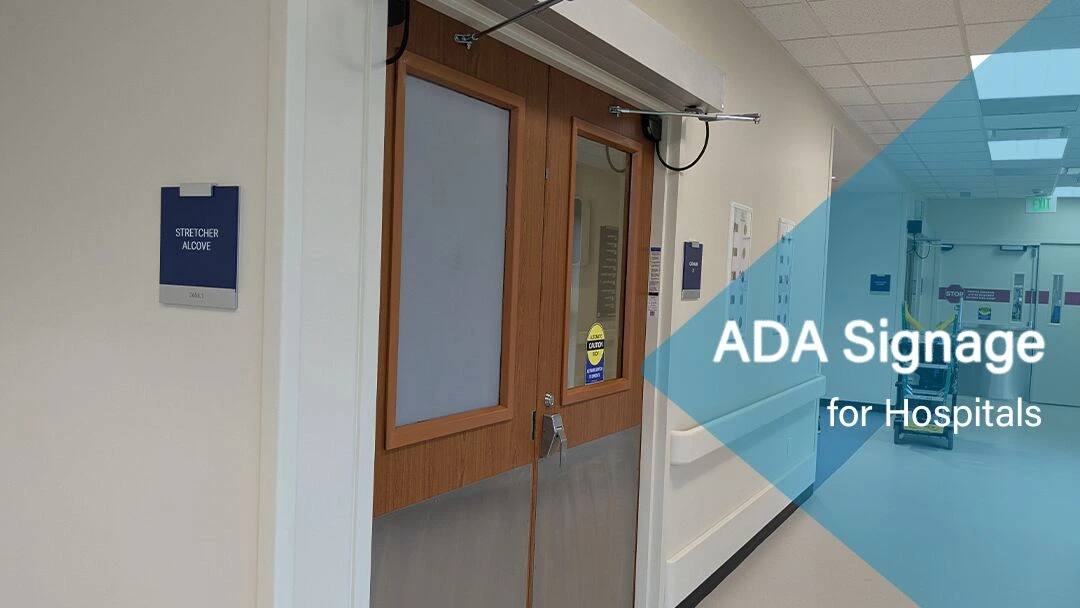Table of Contents
You must have an ADA room identification sign if its use is not likely to change. This description applies to most rooms. The names, labels, or designations for interior spaces or places where the sign is not anticipated to change over time must be included on ADA-compliant signs in particular. The names of rooms, room numbers, and inside signage identifying restrooms are a few examples. The use of pictograms to label or identify a permanent room or location must be accompanied by tactile text descriptors. ADA signs are still a good idea even if they are not legally mandated.

What Particular Rooms Need an ADA Room Identification Sign?
Buildings are required by the Americans with Disabilities Act (ADA) to have compliant signs that offer labels, names, or designations for interior spaces or rooms if the sign is not anticipated to change over time and will perform the same purpose for more than a week.
Interior labels for the following items are typical examples of common interior signs:
- Numbers, letters, or floors for a room
- Rooms for conferences and storage
- Study halls
- Locker rooms
- Electrical spaces
- IT facilities
- Pause areas
- Kitchens
- Machines rooms
- Restrooms
- laundry rooms
- And more
It’s important to note that if the sign includes pictograms that label or identify a permanent place or room, tactile text descriptors are also necessary.
ADA Room Identification Sign Positioning Regulations
A crucial aspect of guaranteeing correct ADA sign placement is comprehending how signs must be positioned, in addition to where ADA-compliant displays must be placed.
Keep in mind the following recommendations while installing ADA signs in a public space:
- On the latch side of the door leading to the room being specified, ADA signs with tactile and braille features ought to be put up.
- The distance from the floor to the bottom of the lowest row of text on an ADA sign should be no less than 48 inches, and the distance from the floor to the top of the tallest row of text should be no more than 60 inches.
- The sign may be mounted on the nearest neighboring wall in a prominent area if there isn’t enough room to mount it in the designated spot.
- ADA signs shouldn’t be fixed directly to doors. With few exceptions, a sign ought to be put on the inactive leaf of double doors that have one active leaf. Suppose there is no wall space available, and the door closes automatically and does not have a hold-open feature. In that case, an ADA sign may alternatively be posted directly on the door.
Contact ALTIUS Graphics right away if you have any more inquiries about ADA sign placement or other compliance requirements.
Ultimately, permanent rooms and other areas related to the security of individuals in a publicly accessible building must display ADA-compliant signs.
ADA Room Identification Sign FAQs
Q1. What rooms require ADA-compliant room identification signs?
Rooms that are used permanently or whose function won’t change, such as restrooms, kitchens, conference rooms, storage areas, and mechanical rooms, must have an ADA room identification sign.
Q2. When is an ADA room sign legally required?
An ADA sign is required if the room serves a permanent purpose and the label or function of the room is not expected to change for at least 7 days or more.
Q3. Do ADA signs with pictograms need tactile text?
Yes. If a pictogram (like a restroom symbol) is used to identify a permanent room, the sign must also include tactile (raised) text and Braille descriptors.
Q4. Where should the ADA room identification sign be placed?
ADA signs must be mounted on the wall adjacent to the latch side of the door, 48 to 60 inches above the finished floor. If that’s not possible, the sign should be placed on the nearest accessible wall.
Q5. Can ADA signs be mounted directly on the door?
ADA signs should not be mounted on doors unless there’s no available wall space and the door closes automatically without a hold-open feature. In that case, it can be placed on the door itself.
Author
-
Sidd is a passionate content creator at ALTIUS Graphics, where signage, design, and storytelling come together. Inspired by bold visuals and impactful branding, he writes with clarity and purpose, covering everything from ADA-compliant signs to eye-catching vehicle wraps. Through every blog, Sidd shares insights that help businesses transform spaces and elevate their brand visibility with confidence.



